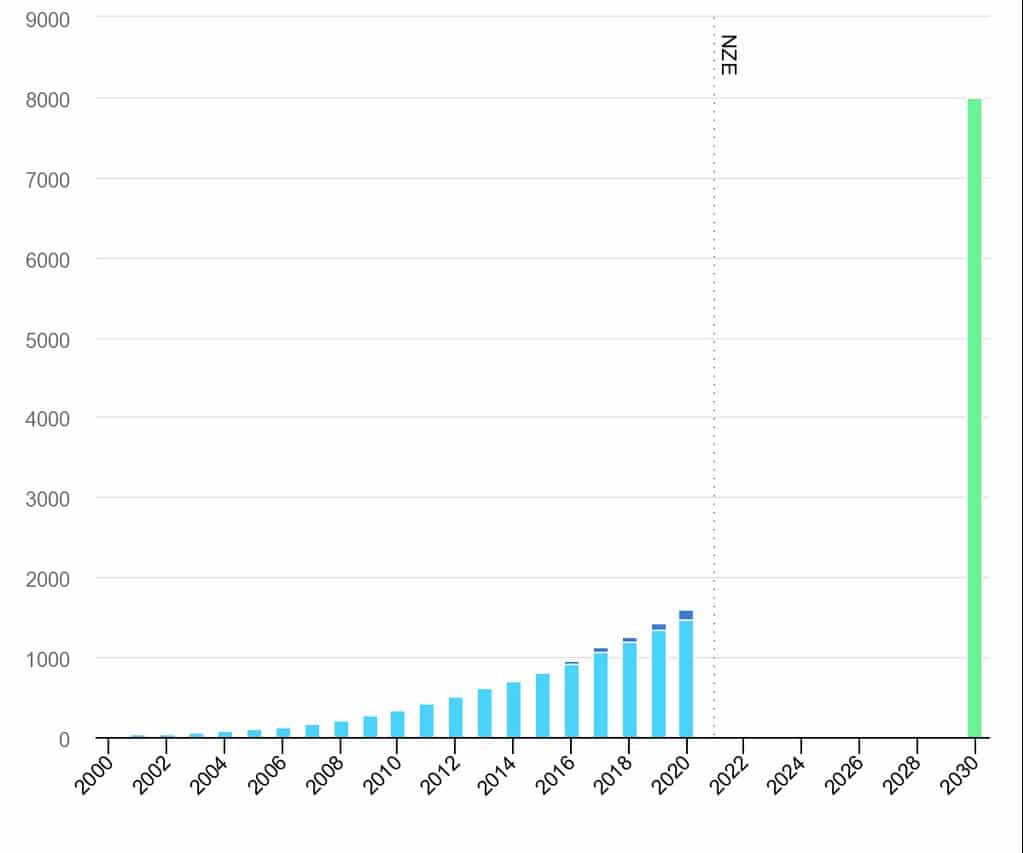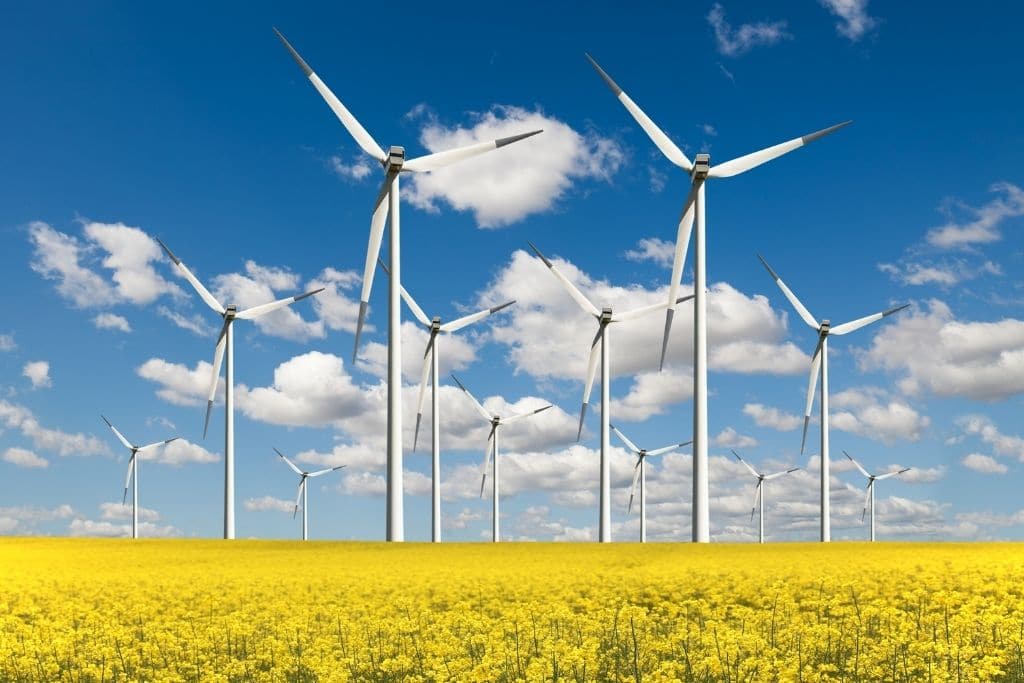In the race to reach net-zero emissions, countries around the world are looking to scale up renewable energy to substitute polluting fossil fuels. Wind power is among the most popular sources of renewable energy, and continued improvements in technology are contributing to its rapid expansion. What makes wind so popular right now and what are some of the main advantages of wind energy?
—
Thanks to research and improvements in technology, wind power is on the rise around the world and on track to become one of the most widely-used renewable energy sources. In 2020, onshore wind electricity generation experienced an 11% growth from the prior year. Wind capacity additions almost doubled, owing to a construction boom in China and the US, which combined accounted for nearly 80% of global wind deployment.
Despite the rapid and unprecedented growth, experts argue that more efforts are required. Under the net-zero emission by 2050 scenario, generation must increase an average of 18% per year within the current decade.

Figure 1: Wind Power Generation in the Net Zero Scenario, 2000-2030
While wind has long served as a power source for humans, from sailors relying on it to power their ships across the sea to farmers using windmills to grind their grains and pump water. Today, smaller turbines erected in a backyard can power a single home or business, while large-scale wind farms can generate electricity to cover an entire country’s demand.
Wind energy comes from huge wind turbines that are sometimes as tall as the Statue of Liberty and have three 200-foot (60-metre)-long blades. When these spin with the force of the wind, they turn a shaft that is connected to a generator, producing electricity.
Currently, onshore is the most popular and widespread type of wind energy. Onshore refers to the power that is generated by wind turbines located on land driven by the natural movement of air. In 2020, its capacity additions almost tripled in China and doubled in the US.

Figure 2: Global Share of Primary Energy from Wind, 2020
When onshore was taking off in the 1980s, Denmark started exploring the idea of offshore wind farms – where turbines are installed in bodies of water to take advantage of the strong force of winds out at sea – and in 1991, the government built the world’s first offshore wind farm.
Despite being less widespread, offshore is rapidly gaining traction as it is considered by many as a much more efficient type of wind power thanks to the higher speed of winds, greater consistency, and lack of physical interference that land-based farms can present. The UK is recognised as the world leader in this technology. In 2020, offshore wind generated enough electricity to supply the needs of nearly 40% of the country’s homes and the government is now betting on this technology to reach net-zero emissions by 2050.
You might also like: 10 Incredible Facts About Wind Energy That Will Blow You Away
4 Advantages of Wind Energy
1. We Will Never Run Out Of Wind Power
As the name suggests, wind power is a resource that never runs out. Unlike fossil fuels, the production of which requires huge efforts, time, and expensive heavy machinery, renewables convert a natural resource – in this case, wind – directly into electricity without the need for fuel to power the turbines.
Because of the huge role they can play in the race to reach net-zero emissions in the coming decades and mitigate the devastating impact of global warming, governments around the world are now investing in renewables as never before. Currently, these clean sources of energy make up 26% of the world’s electricity today, but according to the International Energy Agency (IEA), their share is expected to reach 30% by 2024.
2. Wind Power Generation Does Not Emit Any Greenhouse Gases
Another big factor that makes renewable energy much more attractive than coal, oil, and natural gas is the significant difference in emissions. Contrary to fossil fuels – which are the world’s largest emitter of planet-warming greenhouse gases – renewables are clean energy sources.
Since turbines do not require fossil fuels to work, energy can be produced with little to no impact on the environment. The only time that wind energy indirectly generates emissions is during the manufacturing process as well as the transport and installation of wind turbines. The materials used to produce turbines such as steel, concrete, fiberglass, and copper all produce some amount of greenhouse gases. However, wind still remains a much better alternative to fossil fuels like coal. The latter’s environmental footprint is almost 90 times larger than that of wind while natural gas is more than 40 times bigger. Overall, wind energy produces around 11g of CO2 per kilowatt-hour of electricity generated, compared with about 980g for coal.
As a 2015 study by the US Department of Energy found, if 35% of the country’s electricity was wind-generated by 2050, electric sector greenhouse gas emissions would be reduced by 23%, eliminating 510 billion kilograms of carbon dioxide emissions annually.
3. Offshore Wind Turbines Could Generate 18 Times the Current Global Energy Demand
Thanks to advancements in technology, wind turbines – especially offshore ones – are extremely efficient energy harvesters. This is because higher wind speeds and consistency in direction make energy production possible with far fewer turbines compared to the amount onshore farms would require to generate the same amount of electricity. Based on current technology and market growth, the IEA projects that offshore wind energy has the potential to generate 425,000 TWh of electricity in a year worldwide, more than 18 times the current global demand.
Moreover, while their size and noise have always been among the biggest downsides of this type of renewable, as technology improves, so do the functionalities of the turbines themselves. Nowadays, they can generate more electricity than ever before and because of the advancements in design, they often require less maintenance and can run more quietly and safely.
4. Wind Power Is Getting Cheaper
The surge in growth of wind energy around the world, with generation capacity increasing by 75% since the early 2000s, has contributed to a 70% drop in overall costs over the last decade. While wind turbines come with a hefty upfront price tag, they are still some of the most cost-effective sources of electricity available today. Indeed, once erected, operational costs are close to zero. Furthermore, thanks to advancements in design and technology, they rarely require maintenance.
Along with solar panels, onshore wind is one of the cheapest forms of renewable energy. Offshore, on the contrary, remains almost 20% more expensive and more costly to maintain given their more remote location. However, since it can generate more electricity than onshore with fewer turbines, it still remains a more convenient option.
You might also like: Wind and Solar Power Production in EU Hits Record Amid Energy Crisis
Wind Energy Does Have Its Disadvantages
Wind power certainly comes with its downsides. While the advantages of wind power far outweigh them, it is still worth mentioning the main negative aspects of this renewable source.
One of the main issues of wind energy is the fact that they represent a threat to wildlife, with studies estimating that wind turbines kill between 140,000 and 500,000 birds each year as these are often hit by the fast-moving blades. However, careful planning of where wind farms will be located can significantly reduce the number of bird collisions. Another issue relates to noise, but newer turbines are being built to be quieter than ever. The last drawback has to do with its location limitations. In order to be economically viable and thus produce enough electricity, wind turbines need to be installed in windy areas, which are usually remote places in open planes, close to the coast, or on top of hills. Because of their distance from urban areas, power lines connecting wind farms to a power grid have to be built. This comes with extra costs and can sometimes have repercussions on the environment, as building such infrastructure often requires tearing down trees or altering landscapes.
EO’s Position: Seven years after the ratification of the Paris Agreement in 2015, global GHG emissions are still on the rise and the world is rapidly losing sight of being able to stay under the 1.5C limit of global temperature rise to avoid the catastrophic impacts of climate change. Fossil fuels are without a doubt our worst enemy and the only way out of this crisis is to phase out oil and gas production. Despite coming with some disadvantages, renewables remain our best alternative and we must scale them up as quickly as possible if we want to meet our climate targets and mitigate the impacts of global warming.
You might also like: The Advantages and Disadvantages of Nuclear Energy


















